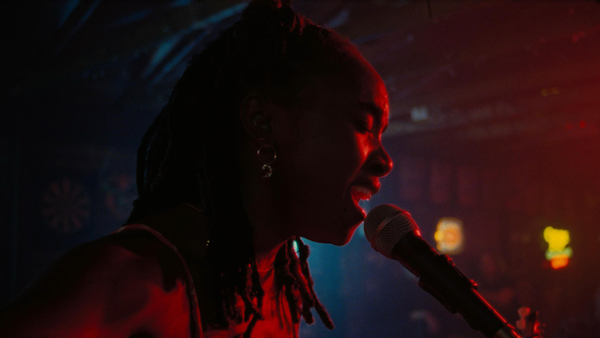Movie review by Greg Carlson
Writer-director Nicole Riegel’s sophomore feature “Dandelion” is now playing in theaters following a world premiere at South by Southwest in March. The movie stars KiKi Layne as the titular singer-songwriter, a young Cincinnati woman looking for artistic and personal fulfillment while holding down a sparsely attended three-night-a-week hotel bar performing gig and caring for her ailing mother. The film’s emphasis on tentative romance and the important connections that happen while making music – the in-universe tunes are provided by twin brothers Aaron Dessner and Bryce Dessner of the National – links many of the vibes to some of the thematic territory more successfully explored by John Carney in “Once,” “Begin Again,” “Sing Street,” and last year’s “Flora and Son.”
When Dandelion’s mom blurts out that there’s “nothing cute” about eventually becoming a “40-year-old troubadour,” the stinging truth and a well-timed notice hyping a South Dakota motorcycle meet-up/live concert opportunity motivates our heroine to get on the road. Soon, Dandelion crosses paths with the charismatic player Casey (Thomas Doherty), a charming Scot whose talents draw others to him like a magnet. Despite some cryptic allusions to the past and a few raised eyebrows from Casey’s fellow bandmates, Dandelion hops on the back of his bike, embarking on a sun-dappled romance stretching through Badlands National Park, roadside prairie dog attractions, and the Sturgis Motorcycle Rally.
Layne, who made an impact in “If Beale Street Could Talk,” works a few minor miracles with what turns out to be a frustratingly underwritten principal role (reviewing for the Roger Ebert site, critic Peyton Robinson argues that the film “often loses sight of its lead” and that “Dandelion feels sidelined in her own story”). The blame for these types of observations belongs in part to a number of curious choices and sour notes composed by Riegel in the script’s handling of a major turn. Without spoiling plot information – though regular moviegoers should be able to sniff out the “shock” long before Dandelion reaches her rock bottom – the comeback during the final act would have worked better had Riegel taken greater pains to flesh out all the key characters.
During the central section, “Dandelion” works best when romantic anticipation builds. Dandelion and Casey are arguably more eloquent and articulate when speaking through their songwriting, and the director runs with it. Riegel constructs several scenes that show precisely how a strong musical collaboration can be every bit as intimate as a physical one. In one bit that calls to mind the erotic intensity of similar time-jumps in Nicolas Roeg’s “Don’t Look Now” and Steven Soderbergh’s tribute to Roeg’s film in “Out of Sight,” Riegel cross-cuts between lovemaking and songcraft as Casey and Dandelion express frustrations in one thread and work them out in the other.
While her two features exist in distinct genre spaces, one can spot a number of similarities between “Dandelion” and 2020’s “Holler.” Both movies carefully and convincingly explore fiercely independent young women who must dig deep to operate within spaces typically dominated by men. Both films are also built around undeniable tour-de-force leads. Jessica Barden’s Ruth in “Holler,” at least outwardly, battles more dire financial circumstances than those that bring Dandelion to part with her beloved Les Paul-style gold top. While “Holler” is the better of the two movies, the triumphant musical number that closes “Dandelion” suggests Riegel has a bright filmmaking future.
